Varied difficulty levels in AP Inter 1st Year Zoology Model Papers Set 7 cater to students with diverse academic strengths and challenges.
AP Inter 1st Year Zoology Model Paper Set 7 with Solutions
Time : 3 Hours
Max. Marks: 60
General Instructions:
Note : Read the following instructions carefully.
- Answer All questions of Section A. Answer ANY SIX questions in Section B and answer ANY TWO questions in Section C.
- In Section A questions from Sr. Nos. 1 to 10 are of “Very Short Answer Type”. Each question carries TWO marks. Every answer may be limited to 5 lines. Answer all these questions at one place in the same order.
- In Section ‘B’, questions from Sr. Nos. 11 to 18 are of “Short Answer Type”. Each question carries FOUR marks. Every answer may be limited to 20 lines.
- In Section ‘C’, questions from Sr. Nos. 19to21areof “LongAnswer Type”. Each question carries EIGHT marks. Every answer may be limited to 60 lines.
- Draw labelled diagrams wherever necessary in Sections ‘B’ and ‘C’.
Section – A (10 × 2 = 20 Marks)
I. Answer all the questions (Very short answer type)
Question 1.
Explain tautonymy. Give one example.
Answer:
The practice of naming the animals, in which the generic name and species name are the same, is called tautonymy. So the name is called tautonym. Eg : Najanaja (Cobra), Axis axis (Spotted deer).
Question 2.
Name two larval forms of sponges.
Answer:
The two larval forms of sponges :
- Amphiblastula,
- Parenchymula.
Question 3.
What is endostyle ? What is its function ?
Answer:
In ascidians and lancelets, ventral side of the pharynx possesses an endostyle which is believed to be the fore runner of the thyroid gland of a vertebrate. It helps in nutrition.
Question 4.
What is biological magnification ?
Answer:
Increase in the concentration of the pollutant of toxicant at successive trophic levels in an aquatic food chain is called Biological magnification or Biomagnification.
![]()
Question 5.
What is paurometabolous development ? Give one example.
Answer:
Cockroach is paurometabolous, which means the development is gradual through nymphal stage.
Question 6.
What is lymph ? How does it differ from plasma ?
Answer:
a) Lymph is a colourless fluid. It lacks RBC, platelets and large plasma proteins but has more number of Leucocytes.
b) Plasma is the fluid matrix of blood. It consists of 92% of water and 8% of solutes.
Question 7.
Define mutualism. Give one example.
Answer:
This type of interaction benefits both the interacting species. Example : Lichens represent an intimate mutualistic relationship between fungus and photosynthetic algae.
Question 8.
The head of cockroach is said to be hypognathous. Justify the statement.
Answer:
The head of cockroach is called hypognathous because it lies hanging almost at right angles to the body with the posterior wider part upwards and the mouth parts directed downwards.
Question 9.
What is nocturnal periodicity ? Give one example.
Answer:
The microfilaria larvae of wuchereria bancrofti in man move in the peripheral blood circulation during the night time between 10 pm and 4 am. This tendency is referred to as nocturnal periodicity. Ex: Culex.
Question 10.
What is nitrogen fixation ? Give one example of an organism that fixes nitrogen.
Answer:
Nitrogen exists in molecular state. The process of conversion of Nitrogen (N2) into nitrites and nitrates is called nitrogen fixation.
Example : Nitrosomonas and Nitrobacter.
![]()
Section – B (6 × 4 = 24 Marks)
II. Answer any six questions (Short answer type)
Question 11.
Describe the system of binominal nomenclature.
Answer:
Binominal Nomenclature : The widely used system of nomenclature throughout the world is the binominal Nomenclature. Carolous Linnaeus, a Swedish botanist, popularised the Binomial Nomenclature and described this system in the 10th edition of his book Systema Naturae. The binomial nomenclature of Linnaeus is referred to as Binominal Nomenclature, in recent times. It is the system in which each organism is provided with an appropriate scientific name consisting of two worlds, the “binomen”.
The first word refers to the genus (pl: genera) and the second word to the species the generic word that refers to the ‘genus’ is a noun, and the specific word that refers to the ‘species’ is mostly an adjective. The generic name begins with a capital letter and the specific name with a small letter. Names must be in Latin or latinised form and are usually printed in italic type. The name of the taxonomist follows the scientific name either in full form or in an abbreviated form e.g. Felis leo linnaeus or Felis leo L The year of the discovery is written after the name of the person who discovered it. e.g. Felis leo Linnaeus, 1758.
Question 12.
Mention the general characters of Holothuroidea.
Answer:
Holothuroidea-salient features:
- This class includes sea cucumbers.
- Body is elongated in the oro-aboral axis.
- Skin is leathery (coriaceous) and dermis contains loose spicules.
- Arms, spines and pedicellariae are absent.
- Mouth is surrounded by retractile tentacles (modified tube feet useful for feeding).
- Ambulacral grooves are ‘closed’; tube feet bear suckers.
- Madreporite is internal (occurs in coelom).
- Respiratory organs are a pair of cloacal ‘respiratory trees’.
- Development is indirect and includes auricularia larva. Examples : Holothuria, Synapta, Thyone.
Question 13.
Mention the general characters of the class Amphibia.
Answer:
- Body is divided into distinct ‘head’ and ‘trunk’. Tail may or may not be present.
- Skin is soft, scale-less (except the members of Apoda), moist and glandular.
- The body bears two pairs of equal or unequal pentadactyle limbs (caecilians are limbless).
- Skull is dicondylic as in mammals. Vertebrae are mostly procoelous (centrum is concave at its anterior face only) in the anurans, amphicoelous in the caecilians and usually opisthocoelous (centrum is concave at its posterior face) in the urodeles. Sternum appeared for the first time in the amphibians.
- Mouth is large; teeth are acrodont, homodont and polyphyodont.
- Respiratory gaseous exchange is mostly cutaneous; pulmonary and bucco pharyngeal respirations also occur. Branchial respiration is performed by larvae and some adult urodeles.
- Heart is three-chambered with sinus venosus and conus arteriosus. Three pairs of aortic arches and well-developed portal systems are present; erythrocytes are nucleate.
- Kidneys are mesonephric; ureotelic.
- Meninges are the inner piamater and outer duramater; cranial nerves are 10 pairs.
- Middle ear consists of a single ear ossicle, the columella auris which is the modified ‘hyomandibula’ of the fishes. Tympanum, lacrimal and harderian glands appeared for the first time in the amphibians.
- Sexes are separate and fertilization is mostly external. Development is mostly indirect, e.g.: Bufo (toad), Rana (frog), Hyla (tree frog), Salamandra (salamander), Ichthyophis (limbless amphibian), Rhacophorus (flying frog).
Question 14.
Give an account of flagellar locomotion.
Answer:
i) Bending movement of flagella: Dynein arms show a complex cycle of movements using energy provided by ATP (dynein arms are the sites of ATPase activity in the cilia and flagella). The dynein arms of each doublet attach to an adjacent doublet and pull the neighbouring doublet. So the doublets slide past each other in opposite directions. The arms release and reattach a little farther on the adjacent doublet and again ‘puli’. As the doublets of a flagellum or cilium are physically held in place by the radial spokes, the doublets cannot slide past much. Instead they curve and cause bending of flagellum or cilium. Such bending movements of flagella and cilia play an important role in the flagellar and ciliary locomotion.
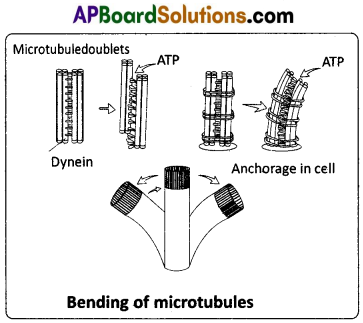
i) Effective stroke : Flagellum becomes rigid and starts bending to one side beating against the water. This beating against water is at right angles to the body axis and the organism moves forwards.
ii) Recovery stroke : Flagellum becomes comparatively soft so as to offer least resistance to water and moves backwards to its original position. It is called ‘recovery stroke’.
![]()
Question 15.
Draw a neat labelled diagram of a multipolar neuron.
Answer:
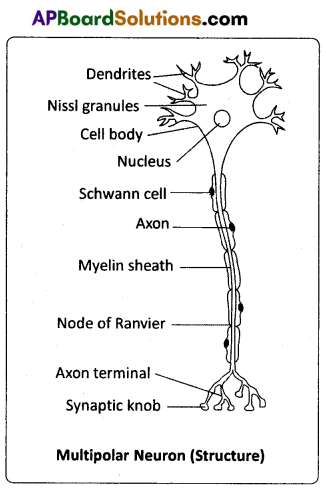
Question 16.
In your view what motivates youngsters to take alcohol or drugs and how can this be avoided ?
Answer:
Curiosity, desire for adventure and excitement, experimentation, are the common causes for the motivation of youngsters towards the use of tobacco, drugs. The first use of drugs or alcohol may be out of curiosity or experimentation, but later the person starts using them to escape facing problems. Recently ‘stress from the pressure to excel in academics or examinations’ has played a significant role in alluring the youngsters to try certain drugs. Television, movies, newspapers and internet also help promoting this wrong perception. Other factors that are associated with tobacco, drug and alcohol abuse among adolescents are unstable or unsupportive family structures and peer pressure.
A lot of help is available in the form of highly qualified psychologists, psychiatrists and de-addiction and rehabilitation programmers. Educating and counselling the adolescents to face problems, stress and failures as a part of life.
Question 17.
Give an account of Haversian system of a compact bone.
Answer:
In a bone between the outer and inner circumferential lamellae, there are many Haversian systems. The spaces between the Haversian systems are filled with interstitial lamellae. Haversian system consists of a Haversian canal that runs parallel to the marrow cavity. It contains an artery, a vein and a lymphatic vessel. Haversian canal is surrounded by concentric lamellae.
Small fluid filled spaces called ‘lacunae’ provided with minute canaliculi lie in between the lamellae. Canaliculi connect the lacunae with one another and with Haversian canal. Each lacuna encloses one osteocyte (inactive form of osteoblast). The cytoplasmic processes of osteocytes extend through canaliculi. A Haversian canal and the surrounding lamellae and lacunae are collectively called a Haversian system or osteon. The Haversian canals communicate with one another, with the periosteum and also with the marrow cavity by transverse or oblique canals called Volkmanns canals. Nutrients and gases diffuse from the vascular supply of Haversian canals.

![]()
Question 18.
Give an account of transverse binary fission.
Answer:
During favourable conditions, Paramecium stops feeding after attaining its maximum growth. At first the micronucleus divides by mitosis and the macronucleus divides into two daughter nuclei by amitosis. The oral groove disappears. After karyokinesis, a transverse constriction appears in the middle of the body, which deepens and divides the parent cell into two daughter individuals, the anterior proter and the posterior opisthe.
The proter receives the anterior contractile vacuole, cytopharynx and cytosome from its parent individual. It develops posterior contractile vacuole and a new oral groove. The opisthe receives the posterior contractile vacuole of its parent. It develops a new anterior contractile vacuole, cytopharynx, cytostome and a new oral groove. Binary fission is completed in almost two hours, in favourable conditions and paramecium can produce four enerations of daughter individuals by binary fission in a day.
The transverse binary fission is also called homothetogenic fission, because the plane of fission is at right angles to the longitudinal axis of the body. As it occurs at right angles to the kineties, it is also called perkinetal fission.

Section – C (2 × 8 = 16 Marks)
III. Answer any two questions (Long answer type)
Question 19.
Describe the mosquito phase of the life history of Plasmodium vivax.
Answer:
Life cycle of Plasmodium in mosquito (The mosquito phase)- Ross cycle : When a female Anopheles mosquito bites and sucks the blood of a malaria patient, the gametocytes along with the other stages of the erythrocytic cycle reach the crop of mosquito. Here all the stages are digested except the gametocytes. Further part of the life cycle consists of:
i) Gametogony
ii) Fertilization
iii) Formation of ookinete & oocysts
iv) Sporogony
i) Gametogony : The formation of male and female gametes from the gametocytes is called gametogony. It occurs in the lumen of the crop of mosquito.
Formation of male gametes : During this process, the nucleus of microgametocyte divides into eight daughter nuclei called pronuclei which reach the periphery. The cytoplasm is pushed out in the form of eight flagella like processes. Into each flagellum like process, one pronucleus enters and forms a micro gamete or male gamete. These male gametes show lashing movements like flagella and get separated from the cytoplasm of microgametocyte. This process is called exflagellation.
Formation of female gamete: The female gametocyte undergoes a few changes and transforms into a female gamete. This process is called maturation. The nucleus of the female gamete moves towards the periphery and the cytoplasm at that point forms a projection. This projected region is called the fertilization cone,
ii) Fertilization : The fusion of male and female gametes is called fertilization. It also occurs in the lumen of the crop of the mosquito. When an actively moving male gamete comes into contact with the fertilization cone of the female gamete, it enters it. The pronuclei and cytoplasm of these two gametes fuse with each other, resulting in the formation of a synkaryon. Since the two gametes are dissimilar in size, this process is known as anisogamy. The female gamete that bears the synkaryon is called the zygote which is round and non – motile.
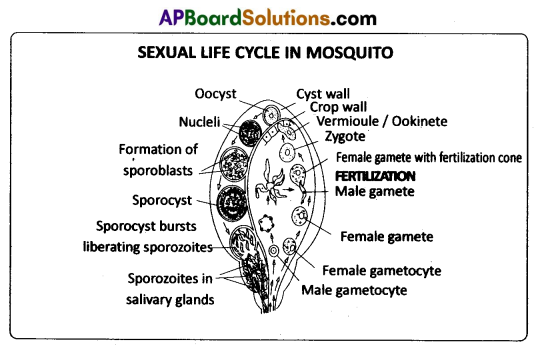
iii) Formation of ookinete and oocysts : The zygote remains inactive for some time and then transforms into a long, slender, motile, vermiform ookinete or vermicule within 18 to 24 hours. It pierces the wall of the crop and settles beneath the basement membrane. It becomes round and secretes a cyst around its body. This encysted ookinete is now called oocyst. About 50 to 500 oocysts are formed on the wall of the crop and appear in the form of small nodules. (Sir Ronald Ross identified these oocysts for the first time).
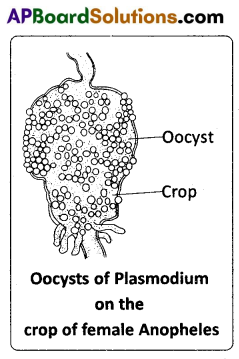
iv) Sporogony : The formation of sporozoites in the oocysts is called sporogony. According to Bano, the nucleus of the oocyst first undergoes reduction division followed by repeated mitotic divisions resulting in the formation of about 1,000 daughter nuclei. Each bit of nucleus is surrounded by a little bit of the cytoplasm and transforms into a sickle shaped sporozoite. Oocyst with such sporozoites is called sporocyst. When this sporocyst ruptures, the sporozoites are liberated into the haemocoel of the mosquito. From there, they travel into the salivary glands and are ready for infection. The life cycle of Plasmodium in mosquito is completed in about 10 to 24 days.
![]()
Question 20.
Describe the digestive system of Periplaneta americana. Add a note on physiology of digestion.
Answer:
The digestive system of cockroach consists of an alimentary canal and the associated glands. The preoral cavity, surrounded by the mouth parts, is present in front of the mouth. The hypopharynx divides it into two chambers called cibarium (anterior) and salivarium (posterior).
Alimentary canal: The alimentary canal of cockroach is a long tubeandiscoiledatsomeplaces.lt extends between the mouth and the anus. It is divided into three regions, namely, foregut or stomodaeum, midgut or mesenteron and hindgut or proctodaeum. The foregut and hindgut are internally lined by ectoderm. The mesenteron is lined by the endodermal cells.
Foregut of stomodaeum : The foregut includes pharynx, oesophagus, crop, and gizzard. It is internally lined by a chitinous cuticle. Mouth opens into the pharynx, which in turn leads into a narrow tubular oesophagus. The oesophagus opens behind into a thin walled distensible sac called crop. The crop serves as a reservoir for storing food. Its outer surface is covered by a network of tracheae.
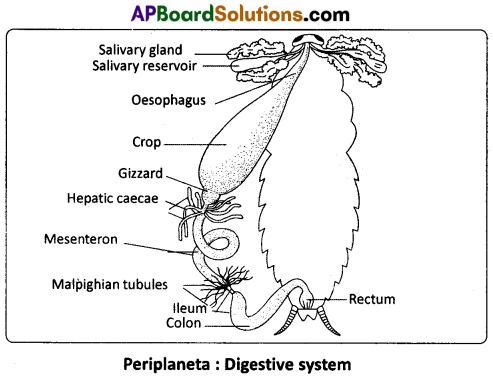
Behind the crop there is a thick walled muscular proventriculus, or gizzard. The chitinous inner lining of the gizzard has six powerful teeth, which form an efficient grinding apparatus. Behind each tooth is a hairy pad, which bears backwardly directed bristles. Among these plates, food is thoroughly ground into fine particles. These food particles are filtered by the bristles. The gizzard thus acts both as a grinding mill and also as a sieve. There Is a membranous projection of the gizzard into the mesenteron in the form of a funnel called stomodeai valve. This valve prevents the entry (regurgitation) of food from the mesenteron back into the gizzard.
Midgut (mesenteron or ventriculus) : The midgut is a short and narrow tube behind the gizzard. It is also called mesenteron or ventriculus. Between the ventriculus and the gizzard, arising from ventriculus, there are six to eight finger like diverticula called hepatic caecae. They are helpful in digestion and absorption of the digested food materials. Ventriculus is functionally divided into an anterior secretory part and a posterior absorptive part.
The secretory part of the ventriculus has many gland cells and it secretes several enzymes. The ‘bolus’ of food in the mesenteron is enveloped by a chitinous and porous membrane called peritrophic membrane, which is secreted by the funnel like stomodeal valve of the gizzard.
Digested food is absorbed into the blood through the peritrophic membrane in the posterior absorptive region of the ventriculus. The peritrophic membrane protects the wall of the ventriculus from hard food particles in the food. The opening of the ventriculus into the hindgut is controlled by a sphincter muscle. It prevents entry of undigested food and uric acid from the hindgut into the midgut.
Hindgut or proctodaeum : The hindgut is a long coiled tube, consisting of three regions namely ileum, colon and rectum, it is internally lined by chitinous cuticle. The ileum that lies behind the mesenteron is a short tube. Six bundles of fine yellow, blind tubules called malpighian tubules open into the ileum near the junction of mesenteron and ileum. Malpighian tubules are excretory in function. Ileum collects uric acid from the malpighian tubules and undigested food from the mesenteron. Ileum opens behind into a long coiled tube called colon. Colon leads into a short and wide rectum, which opens out through the anus. Rectum bears on its inner side six longitudinal chitinous folds called rectal papillae. They are concerned with the reabsorption of water from the undigested food.
Digestive glands : The digestive glands associated with the alimentary canal of cockroach are salivary glands, hepatic caecae and glandular cells of the mesenteron.
Salivary glands : There is a pair of salivary glands attached to the ventrolateral sides of the crop, one on each side. Each salivary gland has two lobes. Each lobe of salivary gland has many lobules called acini. Each acinus is a group of secretory cells called zymogen cells with a small ductule. The ductules of both the lobes of a salivary gland unite to form a common salivary duct on each side.

The two common salivary ducts are joined to form the median salivary duct. Between the two lobes of a salivary gland of each side is a sac called salivary receptacle that stores saliva. It leads into a receptacular duct, or ‘reservoir duct’. The receptacular ducts of both the sides are united to form a common receptacular duct, or ‘common reservoir duct’. The median salivary duct opens into the common receptacular duct. Later these two form an efferent salivary duct. The efferent salivary duct opens at the base of the hypopharynx. Acinar cells secrete saliva, which contains starch digesting enzymes such as amylase.
![]()
Question 21.
Give an account of the flow of energy in an ecosystem.
Answer:
Energy Flow: Except for the deep sea hydro-thermal ecosystem, sun is the only source of energy for all ecosystems on Earth. Of the incident solar radiation less than 50 per cent of it is photosynthetically active radiation (PAR). We know that plants and photosynthetic bacteria (autotrophs), fix Sun’s radiant energy to synthesise food from simple inorganic materials. Plants capture only 2 – 10 percent of the PAR and this small amount of energy sustains the entire living world.
So, it is very important to know how the solar energy captured by plants flows through different organisms of an ecosystem. All heterotrophs are dependent on the producers for their food, either directly or indirectly. The law of conservation of energy is the first law of thermodynamics. It states that energy may transform from one form into another form, but it is neither created nor destroyed. The energy that reaches earth is balanced by the energy that leaves the surface of the earth as invisible heart radiation.
The energy transfers in an ecosystem are essential for sustaining life. Without energy transfers there could be no life and ecosystems. Living beings are the natural proliferations that depend on the continuous inflow of concentrated energy.
Further, ecosystems are not exempted from the Second Law of thermodynamics. It states that no process involving energy transformation will spontaneously occur unless there is degradation of energy. As per the second law of thermodynamics the energy dispersed is in the form of unavailable heat energy, and constitutes the entropy (energy lost or not available for work in a system). The organisms need a constant supply of energy to synthesize the molecules they require.
The transfer of energy through a food chain is known as energy flow. A constant input of mostly solar energy is the basic requirement for any ecosystem to function. The important point to note is that the amount of energy available decreases at successive trophic levels. When an organism dies, it is converted to detritus or dead biomass that serves as a source of energy for the decomposers. Organisms at each trophic level depend on those at the lower trophic level, for their energy demands.
Each trophic level has a certain mass of living material at a particular time, and it is called the standing crop. The standing crop is measured as the mass of living organisms (biomass) or the number of organisms per unit area. The biomass of a species is expressed in terms of fresh or dry weight (dry weight is more accurate because water contains no usable energy).
The 10 percent Law: The 10 percent law for the transfer of energy from one trophic level to the next was introduced by Lindeman (the Founder of the modern Ecosystem Ecology). According to this law, during the transfer of energy from one trophic level to the next, only about 10 percent of the energy is stored / converted as body mass / biomass. The remaining is lost during the transfer or broken down in catabolic activities (Respiration).
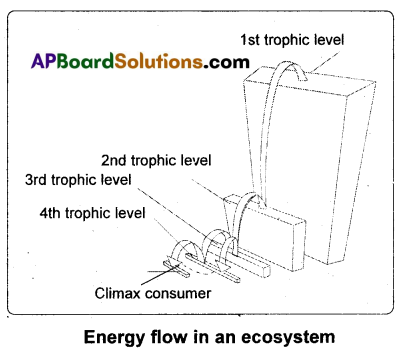
Lindeman’s rule of trophic efficiency /Gross ecological efficiency is one of the earliest and most widely used measures of ecological efficiency. For example, if the NPP (Net primary production) in a plant is 100 kJ, the organic substance converted into body mass of the herbivores which feeds on it is 10 kJ only. Similarly the body mass of the carnivore – I is 1 kJ only.